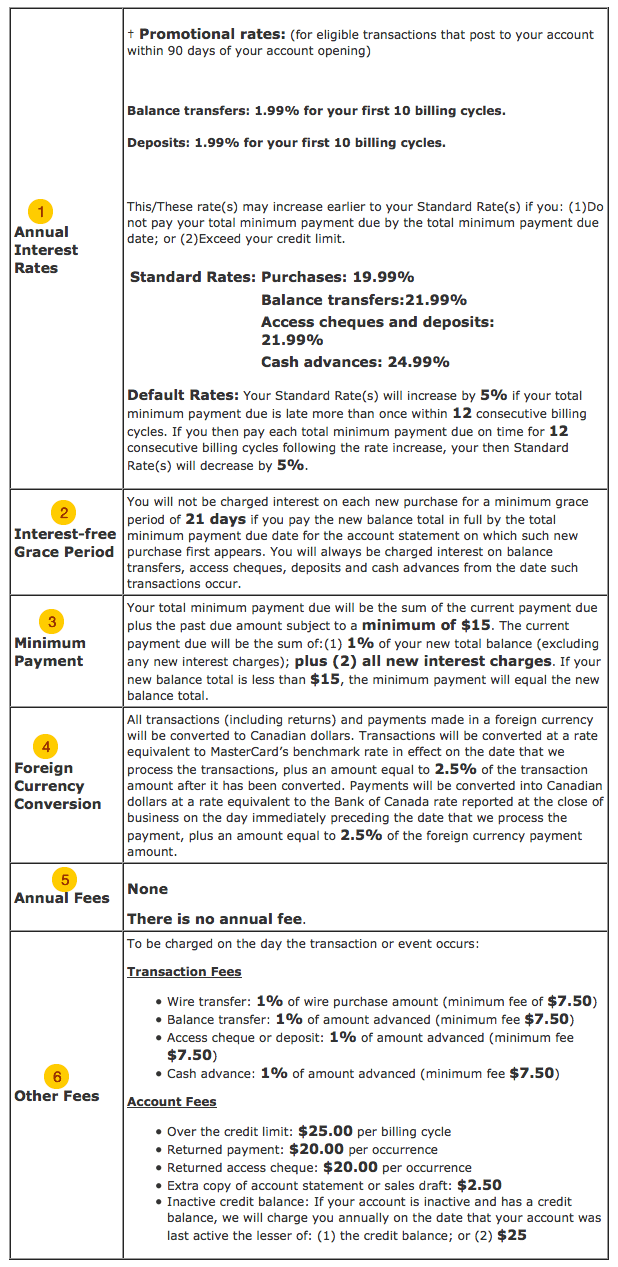Understanding Credit Card Costs
When you apply for a credit card, you have the right to know important information up front from the credit card issuer. The legally-mandated “information box” on credit card applications spell out the associated potential costs of using a credit card, such as the interest rates, fees and other charges. This is also called the Schumer Box in the US.
While it can be easy to let your eyes glaze over the fine print, it’s critical that you review it carefully. When you apply for a credit card, you are also agreeing to all the terms and conditions that come with it.
Costs Spelled Out in The Information Box
Before you apply for your new credit card, you should take some time to review the information box. Here is an example information box, and the important terms to understand.

1. Annual Interest Rates: The annual interest rate is the interest rate you’ll pay when carrying a balance for different transactions, including purchases, balance transfers, cash advances, and any promotional interest rates. You may also face a higher interest rate if your payment is late or you exceed your credit limit. This is often called the “Default Rate”.
2. Grace Period: Specifies the number of days – typically 21 days – you have interest-free to pay off your outstanding balance in full before the due date. It’s important to understand the grace period only applies to purchase transactions, not balance transfers or cash advances.
3. Minimum Payment: The minimum amount you have to pay to keep your account in good standing. By not paying your minimum payment, your interest rate can increase to the default rate and you may incur a late payment penalty fee. The minimum payment is typically the greater of 2% or $15.
4. Foreign Currency Conversion: If you plan to use your credit card out of country, you should pay special attention. This section spells out exactly how you’ll be billed for foreign transactions made on your credit card. When you make a purchase outside of the country you’re billed in Canadian dollars, but the bank has to convert the local currency to Canadian dollars. Many credit cards will charge a fee for this – generally up to 2.5% of the transaction amount. Foreign transactions are typically made based on the exchange rate in effect when the transaction is posted. The credit card processors (Visa and MasterCard for example) generally set the foreign exchange rates at the time of the transaction, so there shouldn’t be a difference between cards. But the actual conversion fee can, and does vary between cards.
5. Annual Fee: A yearly fee for the privilege of cardmembership. Some credit cards come with annual fees, while others don’t. Your annual fee is typically billed on your first statement and on a yearly-basis on your anniversary date after that.
6. Other Fees: These are additional charges that can be incurred on the day of the transaction. These fees typically include going over the credit limit, balance transfers, and requests for extra copies of your statement. For balance transfers, the fee is expressed as a percentage of the dollar amount transferred from your existing credit card to your new credit card. For example, if the fee was 1% of the amount transferred and you’re transferring $5,000, your fee would be $50.
Additional Costs/Fees That May Not Be Present
Cash-Like Transactions: “Cash-like” transactions are typically billed at the cash advance rate. The interest rates are usually much higher than regular transactions – up to 30% – and there are is usually a fee of 1% – 3% based on a percentage of the transaction. Similar to cash advances, there is no grace period; interest starts accruing immediately. Cash-like transactions include lottery tickets, casino chips, wire transfers, money orders, and traveller’s cheques.
Inactivity Fees: While not necessarily out-of-pocket fees, some credit card reward programs will penalize inactive accounts. For example, if you don’t use the card for some time frame, such as one year, the rewards earned may expire or be forfeited.
Additional Credit Agreement Disclosures
Once you are approved for a card, the credit card company is required to send additional disclosures. It is wise to read the agreement carefully so you understand your responsibilities and the terms and conditions of using the card. Some example disclosures that may lead to potential costs include:
Initial Credit Limit: Your maximum spending limit within your 30-day statement period. If you exceed your spending limit your credit card may be declined and you could face penalty charges.
Determination of Interest: Specifies how interest is calculated on your credit card. Interest is typically calculated based on your daily average balance. As long as you pay off your full outstanding balance before the end of your grace period, you’ll avoid paying interest. Again, this only applies to purchase transactions.
Fraud Liability: If a lost or stolen credit card is used in an unauthorized manner, the maximum liability of the borrower. Generally the issuer will offer a zero-liability policy, but this language must be present in the disclosure.
As a credit card holder it’s your responsibility to carefully review the information box before applying for – or using – any credit card. It contains key information on interest rates, fees and charges you may incur. Ignorance is not an excuse. It’s in your best interest to review the information box and any information sent to you after receiving a credit card. By not reviewing it you could face costly penalties outlined in your agreement.




